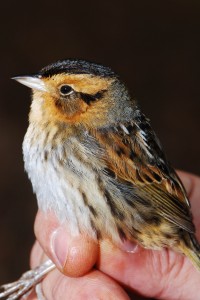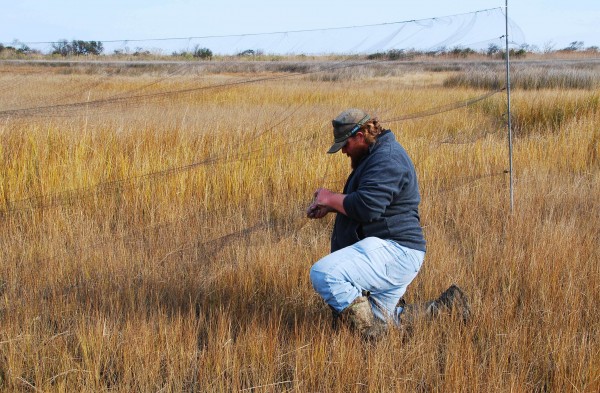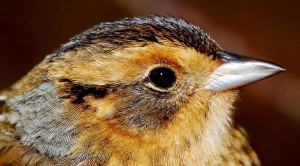Winter investigations of sharp-tailed sparrows
2009 peregrine falcon breeding season
May 9, 2009Welcome to EagleTrak
May 15, 2009
Written by Bryan Watts & Fletcher Smith
May 10, 2009

Nelson’s sparrow (Ammodramus nelsoni nelsoni) captured on Back Bay National Wildlife Refuge. Photo by Bryan Watts.
The sharp-tailed sparrow group has a complex taxonomic history. Initially split, the group was merged into a single species for nearly 7 decades before being re-split in the mid-1990s. The recently named Nelson’s sparrow is comprised of 3 forms, including Ammodramus nelsoni nelsoni (Nelson’s sharp-tail) that breeds in the Canadian prairie, A. n. alterus (James Bay sharp-tail) that breeds along the western shore of James Bay, and A. n. subvirgatus (Acadian sharp-tail) that breeds along the Atlantic Coast south to Maine. The saltmarsh sparrow is comprised of 2 forms including A. caudacutus caudacutus (Eastern sharp-tail) that breeds along the coast from Maine south to New Jersey and A. c. diversus (Southern sharp-tail) that breeds along the coast from New Jersey to Virginia. The southern range limit for breeding for the entire complex is along the Delmarva Peninsula in Virginia near the Accomack and Northampton county border.

Winter habitat of sharp-tailed sparrows along the western shore of the Chesapeake Bay. Photo by Bryan Watts.
All sharp-tailed sparrow forms overlap during the winter months within marsh habitat of the south Atlantic Coast. A recent assessment of winter distribution based on several hundred museum specimens suggests that the core of the winter range for Nelson’s sparrow is more southerly compared to the saltmarsh sparrow but that the center of ranges for all forms is south of North Carolina. Sharp-tailed sparrows are shy in the winter and occupy extensive patches of open marsh habitat. Although the 2 species may be separated in the field with experience, the fleeting glances usually afforded by the birds do not typically allow for the separation of subspecies.

Fletcher Smith extracting a sparrow from mist net. Photo by Bryan Watts.

Saltmarsh sparrow in winter. Photo by Bryan Watts.

Nelson’s sparrow in winter. Photo by Bryan Watts.
Over the past 3 winters, CCB biologists, lead by Fletcher Smith have been investigating the winter ecology of sharp-tailed sparrows in coastal Virginia by capturing, banding, and identifying individuals to subspecies. Our objectives have been to determine habitat requirements, site fidelity, winter density, and the relative abundance and distribution of the 5 subspecies. Working in nearly 2 dozen marsh patches, we have captured and banded more than 240 sparrows. The work is breaking new ground in terms of what we know about this unique species complex. Work will continue during the winter of 2009-2010.
The sharp-tailed sparrow complex (a group of species or forms closely related) is of high conservation concern due to its specialization on a habitat that is very spatially restricted. It appears that the group is particularly vulnerable to sea-level rise and the loss of marsh habitat on their wintering grounds along the south Atlantic Coast.



